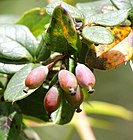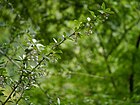Note: This is a project under development. The articles on this wiki are just being initiated and broadly incomplete. You can Help creating new pages.
Difference between revisions of "Berberis aristata"
(→References) |
|||
| Line 66: | Line 66: | ||
<references> | <references> | ||
<ref name="chemical composition">[https://www.researchgate.net/figure/Chemical-constituents-isolated-from-Berberis-aristata-a-Karachine-b-Palmatine_fig2_281863569 Chemical constituents]</ref> | <ref name="chemical composition">[https://www.researchgate.net/figure/Chemical-constituents-isolated-from-Berberis-aristata-a-Karachine-b-Palmatine_fig2_281863569 Chemical constituents]</ref> | ||
| − | <ref name="Leaf">[ | + | <ref name="Leaf">[Morphology]</ref> |
<ref name="How to plant/cultivate">[http://temperate.theferns.info/plant/Berberis+aristata Cultivation]</ref> | <ref name="How to plant/cultivate">[http://temperate.theferns.info/plant/Berberis+aristata Cultivation]</ref> | ||
</references> | </references> | ||
Revision as of 12:08, 2 April 2020
Berberis aristata is an erect, spiny, evergreen shrub. It can grow up to 5 metres tall. The plant is harvested from the wild for local use as a food, medicine and source of materials and for the fruits. It is sometimes grown as an ornamental in gardens, where it can be used as a hedge.
Contents
- 1 Uses
- 2 Parts Used
- 3 Chemical Composition
- 4 Common names
- 5 Properties
- 6 Habit
- 7 Identification
- 8 List of Ayurvedic medicine in which the herb is used
- 9 Where to get the saplings
- 10 Mode of Propagation
- 11 How to plant/cultivate
- 12 Commonly seen growing in areas
- 13 Photo Gallery
- 14 References
- 15 External Links
Uses
Malaria, Eye complaints, Skin diseases, Menorrhagia, Diarrhoea, Jaundice.
Parts Used
Chemical Composition
It contains Chemical constituents isolated from Berberis aristata. Karachine, Palmatine chloride, Tetrahydropalmatine.[1]
Common names
| Language | Common name |
|---|---|
| Kannada | |
| Hindi | |
| Malayalam | |
| Tamil | |
| Telugu | |
| Marathi | |
| Gujarathi | |
| Punjabi | |
| Kashmiri | |
| Sanskrit | |
| English |
Properties
Reference: Dravya - Substance, Rasa - Taste, Guna - Qualities, Veerya - Potency, Vipaka - Post-digesion effect, Karma - Pharmacological activity, Prabhava - Therepeutics.
Dravya
Rasa
Guna
Veerya
Vipaka
Karma
Prabhava
Habit
Identification
Leaf
| Kind | Shape | Feature |
|---|---|---|
Flower
| Type | Size | Color and composition | Stamen | More information |
|---|---|---|---|---|
| {{{5}}} |
Fruit
| Type | Size | Mass | Appearance | Seeds | More information |
|---|---|---|---|---|---|
Other features
List of Ayurvedic medicine in which the herb is used
Where to get the saplings
Mode of Propagation
Seeds, Cuttings of mature wood, Cuttings of half ripe wood.
How to plant/cultivate
Berberis aristata is able to tolerate quite severe winters - it is known to have survived temperatures down to -15°c without damage.[3]
Commonly seen growing in areas
Photo Gallery
References
- ↑ Chemical constituents
- ↑ [Morphology]
- ↑ Cultivation
External Links
- [ ]
- [ ]
- [ ]
- Ayurvedic Herbs known to be helpful to treat Malaria
- Ayurvedic Herbs known to be helpful to treat Eye complaints
- Ayurvedic Herbs known to be helpful to treat Skin diseases
- Ayurvedic Herbs known to be helpful to treat Menorrhagia
- Ayurvedic Herbs known to be helpful to treat Diarrhoea
- Ayurvedic Herbs known to be helpful to treat Jaundice
- Herbs with Fruits used in medicine
- Herbs with Flower buds used in medicine
- Habit - Evergreen shrub
- Index of Plants which can be propagated by Seeds
- Index of Plants which can be propagated by Cuttings of mature wood
- Index of Plants which can be propagated by Cuttings of half ripe wood
- Herbs that are commonly seen in the region of Shrubberies
- Herbs that are commonly seen in the region of Open hillsides
- Herbs
- Pages without herbs images



